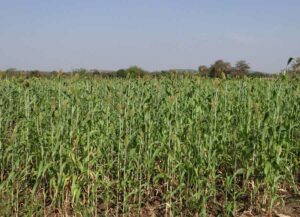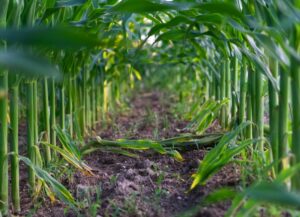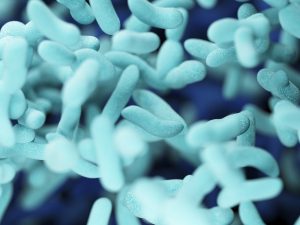Francisco E. Contreras Govea, Ph.D
Corn for silage is one of the most important crops to feed the dairy and beef cattle. In the United States, on average, 2.492 millions of ha are harvested and ensiled (Ferraretto et al., 2018). Some of the advantage of corn over other forages are lower harvesting cost, high yield per area, and the possibility of harvesting either for grain or silage depending on the market price. In addition, corn for silage has high energy value and provides effective fiber to maintain rumen health. Therefore, any new technology or alternatives to improve the nutritive value of corn for silage is worth it.
In a recent literature review, Ferraretto et al. (2018) describes the most recent advances for harvesting and processing corn for silage to increase the nutritive value such as: harvesting maturity, kernel processing, theoretical length of cut, and cutting height. However, no information is reported in this review about foliar applications to the corn to improve the nutritive value.
Recently, Hollis et al. (2019) reported a study that was conducted to assess the effect of foliar fungicide application on BMR and floury corn varieties for silage. The foliar fungicide was applied at tasseling stage of each variety. Plant samples were taken at this maturity stage, tasseling, and at kernel dent stage (R5) to assess differences between control (no fungicide) and fungicide treated plants. Corn plants were separated in leaves, stalk, and cob and analyzed for dry matter (DM), crude protein (CP), neutral detergent fiber (NDF), acid detergent fiber (ADF), and lignin, among other parameters.
In addition to the pre-harvest evaluation, at harvest, samples of BMR corn (treated and no-treated), and floury corn, (treated and no-treated), were ensiled in vacuum sealed plastic bags and fermented for up to 150 days. Corn silage samples were analyzed for the same parameters mentioned above plus starch content, NDF digestibility 30 h (NDFD), undigestible NDF (uNDF), and starch digestibility (Table 1).
Either in BMR or floury corn, the number of yellow leaves was lower in those plots where fungicide was applied. However, some of the results were contrasting between the two corn varieties. For example, for the BMR corn DM yield was higher on the no-fungicide (20.2 ton/ha) relative to fungicide (18.2 ton/ha), while floury corn there was small difference between no-fungicide (18.4 ton/ha) and fungicide (18.9 ton/ha).
Relative to silage nutritive value between treated and no-treated, there was not a consistent effect of the fungicide on any of the two corns (Table 1). The only consistent effect were the nutritive value differences between the two corn, lower lignin and greater NDF digestibility on the BMR relative to floury, and greater starch digestibility on the floury relative to the BMR.
The authors concluded from this study that application of fungicide resulted in healthier corn plants, but no-fungicide applied yielded more. Moreover, BMR with fungicide and fermented for 150 days yielded the best silage for dairy cows.
Certainly, it is possible that corn plants with fungicide looked healthier than corn plants without fungicide. However, the results from this study indicated that there was not a consistent and positive effect of the fungicide on corn nutritive value. In addition, looking at the values of NDF digestibility and the lack of statistical differences among treated and no-treated, the data does not support the last conclusion.
Table 1. Nutritive value (% of DM) of BMR and floury corn varieties with and without fungicide after fermentation for 150 d.
| Item | BMR | Floury | |||
| No-fungicide | Fungicide | No-fungicide | Fungicide | ||
| DM | 32.1 | 30.7 | 33.5 | 33.5 | |
| Ash | 5.0 | 5.1 | 4.7 | 4.7 | |
| NDF | 36.0 | 34.6 | 37.5 | 39.4 | |
| ADF | 17.6 | 17.8 | 20.0 | 20.1 | |
| Lignin | 1.9 | 1.8 | 2.6 | 2.7 | |
| Starch | 34.7 | 34.7 | 35.3 | 34.6 | |
| NDFD 30 | 59.3 | 60.0 | 47.8 | 49.1 | |
| uNDF | 8.3 | 8.2 | 11.2 | 11.0 | |
| Starch digestibility | 38.4 | 44.3 | 44.0 | 41.4 | |
| DM=dry matter; NDF=neutral detergent fiber, ADF=acid detergent fiber, NDFD 30= NDF digestibility at 30 h; uNDF= undigestible NDF | |||||
References
- Ferraretto, L. F., R. D. Shaver, and B.D. Luck. 2018. Silage review: recent advances and future technologies for whole-plant and fractionated corn silage harvesting. J. of Dairy Sci. 101:3937-3951.
- Hollis, M. E., R. T. Pate, S. Mideros, G. M. Fellows, M. Akins, M. R. Murphy, F. C. Cardoso. 2019. Foliar fungicide application effects on whole plant BMR and floury corn varieties, and whole plant corn silage composition. Animal Feed Sci and Technol. 257.
© 2019 Dairy Knowledge Center, LLC. All Rights Reserved.











